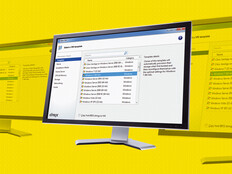How Flash Storage Optimizes Backup and Recovery for the Evolving Healthcare Landscape
As we all recover from the daylight saving time change, it’s time to gear up for another spring event on March 31: World Backup Day. This independent initiative aims to help people learn about the increasing role that data plays in our lives and the importance of regular backups. The event also provides an opportunity to focus on rapid restore — the flip side of disaster preparedness — which becomes more vital by the day.
Certainly, healthcare providers understand the critical nature of data, perhaps better than anyone. Having access to the right data at the right time can literally save lives. As data continues to grow in volume and complexity, providers need strong processes and technology in place to ensure they can protect, manage and access their data anytime, anywhere. That includes protecting data assets that are constantly changing and moving across hybrid cloud environments.
In addition, healthcare organizations are a prime target for malicious cyberattacks, including ransomware, which can restrict access to a critical system and its data until a payment is made — making it impossible for providers to access the data they need to effectively treat patients.
Given these challenges, modern backup is essential.
MORE FROM HEALTHTECH: Check out how the cloud improves backup and recover for healthcare orgs.
Backup Is More Than a Compliance Play in Healthcare
HIPAA mandates that providers keep a backup copy of all protected health information, and for many years they have backed up to both ensure compliance and guarantee access to health data in case something went wrong. Organizations regularly backed up to tape or virtual tape libraries based on spinning disks, and conducted restore tests a few times a year — a process that could take days — hoping that they would never actually have to do it for real.
The restore side of the equation typically has been addressed with much less urgency than the backup itself. But in today’s world, where a CryptoLocker ransomware attack can restrict access to all data in a provider’s environment, organizations cannot afford to wait for hours or days to restore their systems. Data must be usable, and rapid restore is critical; it can’t be locked on a tape, in a warehouse or on a slow spinning disk. Any delay can affect critical clinical and administrative workflows that support patient care.
If the restore process is slow, a hospital may need to revert to paper in the interim, which introduces risk as it represents a change in the process and negatively impacts efficiency and patient data security.
In most healthcare IT environments, applications, data silos and interfaces have multiplied in the wake of digital transformation driven by the shift to electronic health records. Consequently, most data backup scenarios include multipoint solutions and appliances that create significant complexity, making it difficult to assess data protection efforts and predict data recovery performance.
Some progressive organizations, however, are turning to flash storage for primary storage and backup, particularly for mission-critical applications such as EHRs and virtual desktop infrastructure. The performance and availability benefits offered in production and backup environments can provide significant improvements in patient care and clinical efficiency. What’s more, with the right solution in place, flash technology can deliver reductions in total cost of ownership for providers of all sizes.
As analytics and artificial intelligence gain traction in healthcare, flash storage — and the rapid restore it enables — also creates a new opportunity to use data for purposes beyond security or disaster recovery. Providers can run search algorithms against the data to identify patterns and derive insights that can help them pinpoint areas for organizational and clinical improvement.
To support this rapid restore and secondary use, organizations need an appliance that is not purpose-built for just one function. An all-flash platform provides a strong option, as it can be used as a data hub, enabling both a modern backup environment and the exploration of secondary uses of the data that may have far-reaching benefits across the healthcare environment.
As we observe World Backup Day, let’s remember that in today’s complex environment, backup is a great start, but it’s not enough as data volumes continue to balloon, compliance requirements become more stringent and malicious actors loom. Rapid restore is critical to backup success, and flash storage provides a powerful means for ensuring data accessibility and usability at a moment’s notice.









